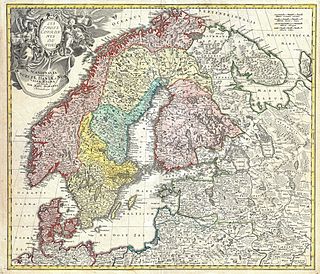
The history of Denmark as a unified kingdom began in the 8th century, but historic documents describe the geographic area and the people living there—the Danes—as early as 500 AD. These early documents include the writings of Jordanes and Procopius. With the Christianization of the Danes c. 960 AD, it is clear that there existed a kingship. King Frederik X can trace his lineage back to the Viking kings Gorm the Old and Harald Bluetooth from this time, thus making the Monarchy of Denmark the oldest in Europe. The area now known as Denmark has a rich prehistory, having been populated by several prehistoric cultures and people for about 12,000 years, since the end of the last ice age.

Hans Tausen (Tavsen) nicknamed the “Danish Luther” was the leading Lutheran theologian of the Danish Reformation in Denmark. He served as Bishop of Ribe and published the first translation of the Pentateuch into Danish in 1535.

Aarhus Cathedral is a cathedral in Aarhus, Denmark. It is the longest and tallest church in the country, at 93 m (305 ft) in length and 96 m (315 ft) in height.
Jørgen Jensen Sadolin was a Danish reformer and first protestant bishop of the Diocese of Funen.
Poul Helgesen was a Danish Carmelite, a humanist and historian. Helgesen was a mendicant monk who at first supported Christian II and the Lutheran reform movement, but later broke with both and wrote warnings against the tyrannical king and the Lutheran preachers. Like his role model Erasmus of Rotterdam, Helgesen found himself in the gray area between Catholicism and Protestantism.

The former Diocese of Børglum was a Roman Catholic diocese in Northern Jutland, Denmark. It has also been referred to as the Diocese of Vestervig or the Bishopric of Vendsyssel. The diocese included the historic districts of Vendsyssel, Hanherred, Thy, and Mors.

Antvorskov Monastery was the principal Scandinavian monastery of the Catholic Order of Saint John of Jerusalem, located about one kilometer south of the town of Slagelse on Zealand, Denmark.
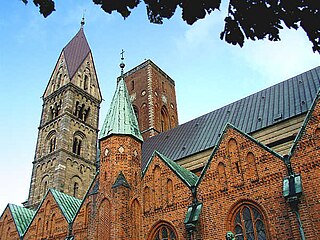
The former Diocese of Ribe was a Roman Catholic diocese in Southern Jutland, Denmark. The diocese was established in 948, and dissolved in 1536 during the Protestant Reformation. Within the newly established protestant Church of Denmark, the Diocese of Ribe effectively replaced its Roman Catholic precursor.
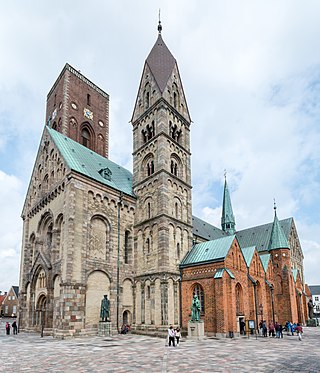
Ribe Cathedral or Our Lady Maria Cathedral is located in the ancient city of Ribe, on the west coast of southern Jutland, Denmark. It was founded in the Viking Age as the first Christian church in Denmark by Ansgar, a missionary monk from Hamburg, under permission of the pagan King Horik I. The cathedral has experienced several damaging events throughout its long history and has been restored, expanded and decorated repeatedly. As it stands today, Ribe Cathedral is the best preserved Romanesque building in Denmark, but reflects a plethora of different architectural styles and artistic traditions. It ranks among the most popular tourist attractions in Denmark and has been awarded two stars in the Michelin guide.
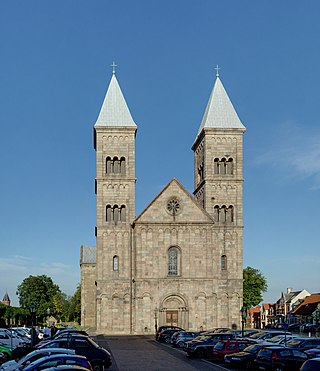
Viborg Cathedral, Our Lady Cathedral is the site of one of Denmark's most important historic churches located in the town of Viborg in northern Jutland. The modern building is a 19th-century construction based on Lund Cathedral in southern Sweden which bears no resemblance to the medieval cathedral that stood on the site since 1130.

Børglum Abbey was an important Premonstratensian abbey of medieval Denmark, located in Børglum parish, in the commune of Hjørring, approximately five kilometers east of Løkken in north central Jutland from the 12th century until reformation.
The Chronicle of the Expulsion of the Greyfriars is a historical writing on the Reformation in Denmark between 1527 and 1532 when the Franciscans were forced to leave Denmark.

During the Reformation, the territories ruled by the Danish-based House of Oldenburg converted from Catholicism to Lutheranism. After the break-up of the Kalmar Union in 1521/1523, these realms included the kingdoms of Denmark and Norway and the Duchies of Schleswig and Holstein, whereby Denmark also extended over today's Gotland and Øsel in Estonia.

The former Diocese of Viborg was a Roman Catholic diocese in Denmark. It was established in 1065 and was dissolved in 1536 during the Protestant Reformation.
Saint Canute's Abbey, Odense was a Benedictine monastery built to support the pilgrimage centre for the relics of the royal Danish martyr Saint Canute, and was the successor to the priory of St. Mary and St. Alban, Denmark's earliest monastic house. Located in Odense, it was the island of Funen's most important medieval religious institution.
St. Peter's Priory was an early Augustinian monastery located between the towns of Grinderslev and Breum, in north central Denmark.
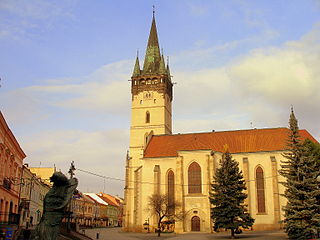
In 16th-century Christianity, Protestantism came to the forefront and marked a significant change in the Christian world.
Anders Foss was a Norwegian clergyman and Bishop of Bergen.
Events from the 1520s in Denmark.
Catholic–Protestant relations refers to the social, political and theological relations and dialogue between Catholic Christians and Protestant Christians.